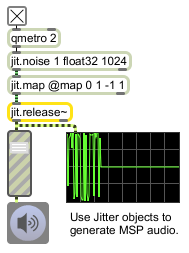Examples

Transforms matrix data into signals
| Name | Type | Opt | Description |
|---|---|---|---|
| channels | The number of output signals. An outlet will be created for each channel and the input matrices should be composed of a separate plane for each channel. |
| Name | Type | g/s | Description |
|---|---|---|---|
| mode | int | Two different modes are possible: in mode 0, jit.release~ does no intepolation and expects to receive one sample of input for every sample it needs to output. In mode 1 the playback position within the internal buffer is smoothly adjusted based on how much data has been made available to the object. | |
| latency | float | The amount of signal data, in milliseconds, that the object should internally buffer before starting playback. Low latency values will be more susceptible to clicking due to temporal perturbations in the event-based jitter network. |

| Name | Description |
|---|---|
| jit.buffer~ | A matrix-friendly MSP buffer~ |
| jit.peek~ | Read matrix data as an audio signal |
| jit.poke~ | Write an audio signal into a matrix |
| jit.catch~ | Transforms signal data into matrices |
| peek~ | Read and write sample values |
| poke~ | Write sample values to a buffer by index |
| Tutorial 48: Frames of MSP signals | Tutorial 48: Frames of MSP signals |